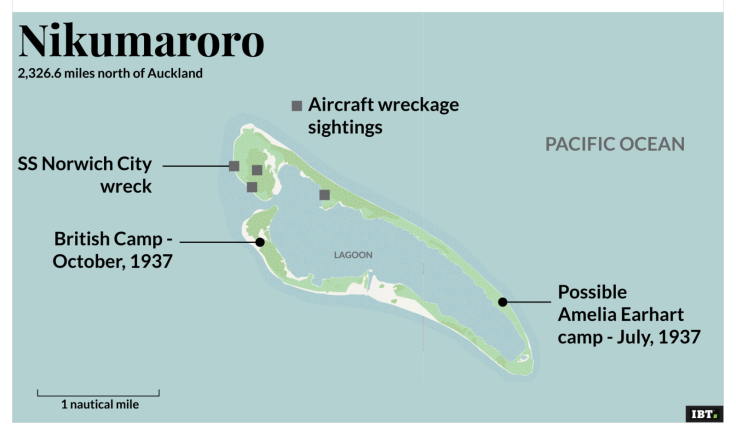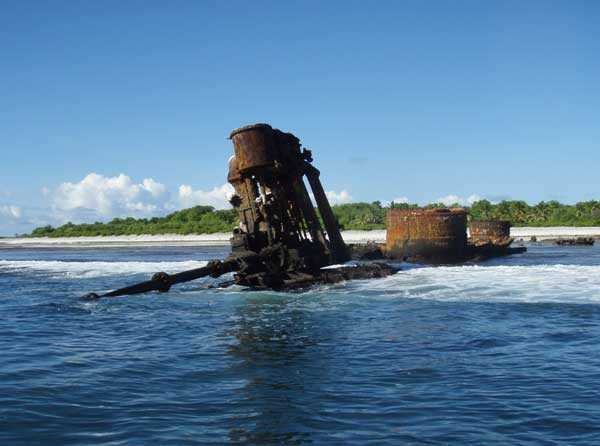Could British colonial explorers have saved Amelia Earhart as she lay dying on a Pacific island?
British party were three miles from 'Castaway Camp' just three months after the plane crash.
If Amelia Earhart and Fred Noonan's plane did crash-land on Gardner Island on 2 July, 1937, the world-famous pilot and her navigator may have come excruciatingly close to being rescued.
Not only had US planes flown over the island (since re-named Nikumaroro) during the search for Earhart, but three months later a British delegation landed and camped just three miles from where they may have been.
Earhart, the first woman to fly solo across the Atlantic, and Noonan were four months into an attempt to circumnavigate the globe when they went missing. Earhart and Noonan are believed to have made camp in the south-east of Nikumaroro after their plane landed on the reef further north on the then uninhabited and remote Pacific island.
In 1940 a partial skeleton, a sextant box and a two shoes were discovered on the site as well as fish, animal and bird bones.
In October 1937, a British delegation headed by colonial officer and Phoenix Islands Settlement Scheme leader Harry Maude landed on the other side of the island, which is set around a large lagoon, along with his assistant Eric Bevington and 18 Gilbertese (now known as Kiribati) islanders. The party had come to Nikumaroro to see if it could be used to re-settle residents of neighbouring islands.
They bedded down for the night close to the wreck of the SS Norwich City, a British steamer that ploughed into the island's reef in 1929 as it headed for Vancouver, Canada, from Melbourne, Australia, and the next day walked the circumference of the atoll. But the party forgot to take water and struggled to get back to camp.
"Bevington took a party of a half dozen Gilbertese and walked around the circumference of the atoll. The maps at that time were inaccurate and he had a greatly mistaken impression of the size of the island," Ric Gillespie executive director of the International Group for Historic Aircraft Recovery (TIGHAR), told IBTimesUK.

"By the time they rounded the south-east tip and started up the long northern shore they were in trouble, not doing any exploring but just trudging along the beach near the water where the sand is hard and the walking is easiest."
By taking the beach, the party would not only have been unable to see the Castaway Campsite where Earhart and Noonan could have been because of the dense vegetation, but the roar of the surf and the wind rushing through the trees would have made it impossible to hear them: "Earhart could have been alive and the Bevington party could have walked right past where she was camped," said Gillespie.
And while critics have argued that even if Maude and his party missed the campsite, they surely cannot have missed the wreckage of Earhart's plane, TIGHAR believes that the hulking remains of the SS Norwich City could have obscured any remains of the aircraft that remained on the reef. By the time Maude returned in 1938 with 80 Kiribati islanders to set up the first settlement on Nikumaroro since 1892, the wreckage of the plane had sunk.
Both the crabs and birds were very good eating, and we gorged ourselves
But while it is a tantalising prospect to imagine how close Earhart and Noonan came to being found – by accident, no less – Gillespie, who has visited many times, said the likelihood was that they were dead by October 1937. "It seems possible that she was still alive, although three months is, in my opinion, at the extreme end of how long she may have survived," he said.
The pair could also have been injured during the crash. In the days following the crash there were reports of dozens of distress calls made by Earhart and Noonan, including one to Florida teenager Betty Klenck that suggested that Noonan had suffered a serious head injury and may have died early on. Any injuries to either Earhart or Noonan would have made surviving on a desert island long-term all the more difficult.

One of the missions of the British delegation was to determine if the islands could sustain life, which would have been key if Earhart and Noonan were to survive even the earliest weeks on Nikumaroro. Maude reported that the island had only 111 coconut trees, which had been planted in the 1890s by a Pacific entrepreneur, John Arundel. The trees had taken 40 years of battering by harsh Pacific winds and had "gone fallow", Maude said.
As for life on the islands, Maude was more poetic: "We lay in a circle under the shade of the giant buka trees by the lagoon, ringed by fires as a protection against the giant robber crabs, who stalked about us in the half-light or hung to the branches staring balefully at us.
"Birds were everywhere and for the most part quite tame. Unfortunately for them, both the crabs and birds were very good eating, and we gorged ourselves," he said.
Commander Charles Wilkes of the USS Vincennes also described the abundant birdlife on Nikumaroro when he visited 12 years after the atoll was first discovered in 1828. Wilkes commented on the "numerous" tame birds on the island from which the sailors collected "beautiful tail feathers". He said that as well as the birds, the crew discovered a huge rat. But while any castaways could have eaten well, the real challenge was water.
Even decades after the island was again abandoned in 1963, those who settled there in 1938 (and who live today in a village called Nikumaroro in the Solomon Islands) still have songs about the "great search for water" that preoccupied their ancestors.
Maude's Phoenix Islands Settlement Scheme – which became known by the unfortunate acronym "PISS" – always struggled to find water on Nikumaroro despite having the resources of the British government behind them. Earhart and Noonan would likely have had even less success.
There are those who believe that Earhart and Noonan went down in the Pacific during their record-breaking flight – and others still that say they were captured and executed by the Japanese as US spies. But Gillespie and TIGHAR believe that after 22 years the evidence for the Nikumaroro theory is conclusive. The mystery of Earhart's and Noonan's disappearance can finally be put to rest.
© Copyright IBTimes 2024. All rights reserved.







